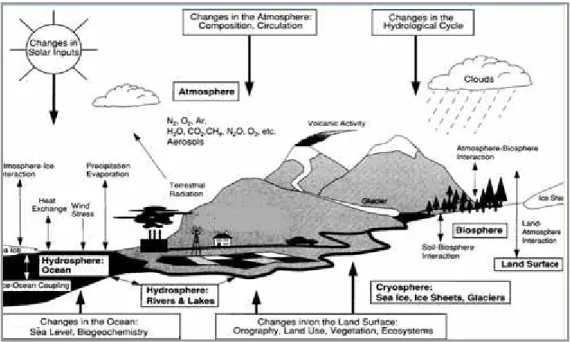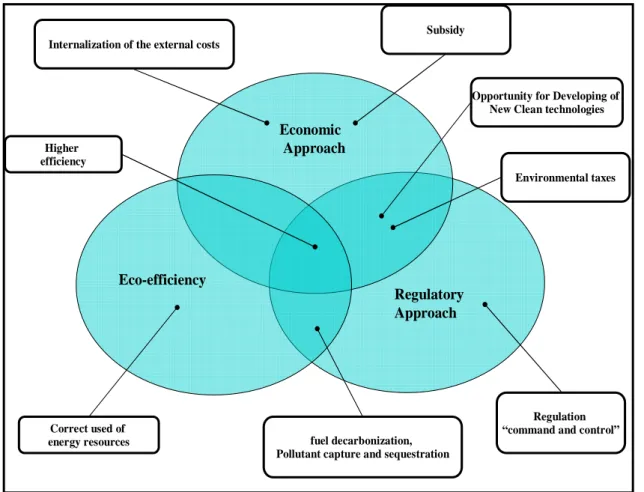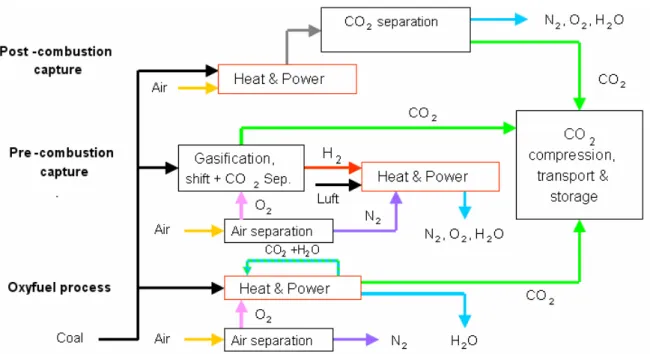iii
Introduction and objective of the thesis
Generalities and Motivation of the work
The United Nations has just released (2 February 2007) its long-awaited report on climate change, warning global warming is almost certainly caused by humans. "Warming of the climate system is unequivocal, as is now evident from observations of increases in global average air and ocean temperatures, widespread melting of snow and ice, and rising global mean sea level," the report said, see figure 1. What little debate still existed regarding human causality for climate change has been squashes as the United Nation's Intergovernmental Panel on Climate Change (IPCC) has issued their strongest statement yet that "very likely" human activities(>90% chance) are changing the climate. “Most of the observed increase in globally averaged temperatures since the mid-20th century is very likely due to the observed increase in anthropogenic greenhouse gas concentrations. Global atmospheric concentrations of carbon dioxide have increased markedly as a result of human activities since 1750. The atmospheric concentration of carbon dioxide in 2005 exceeds by far the natural range over the last 650,000 years as determined from ice cores”. The report continues saying -“the global increases in carbon dioxide concentration, -being the most important anthropogenic greenhouse gas-, since the pre-industrial period results primarily from fossil fuel used, with land-use change providing another significant but smaller contribution”.
Introduction and objectives of the thesis
iv
Figure 1: Shows the main changes that have took place in the earth due to the human
activities1
Accordingly, climate change induced by anthropogenic emissions is predominantly the result of the lifestyle to which people living in the industrialized countries have grown accustomed. However, to estimate the environmental damages cause by the human activities still incorporates an appreciable number of uncertainties, which are largely raise by the incapacity of working with such a huge amount of interrelated variables and with the lack of accurate information about the physic and chemistry processes driving the climate on earth.
It should be noted, anyway, that these inaccuracies do not deny the fact that as a result of the anthropogenic CO2 emissions, which are responsible for about 64% of the enhanced greenhouse effect, carbon dioxide atmospheric concentration have risen by 35% from a pre-industrial value of about 280 ppm to 379 ppm in 2005. As already
1 IPCC 2001. Climate Change 2001: The Scientific Basis Contribution of Working Group I to the Third Assessment Report of the Intergovernmental Panel on Climate Change [Houghton ,J.T. et al. (eds.)]. Cambridge University Press, Cambridge, UK
v
being the most CO2-intensive fossil fuel (twice as much CO2 per kWh as Gas, and 50% more than oil) has triggered off discussions about its wide use in the energy industry sector, rising to the question; why in the 21st century coal is still the main fossil fuel used to produce energy? The answer involves several considerations:
On the one hand, at the current state of development, the levels of risk and cost of the non-fossil energy alternative such as nuclear, biomass, solar or wind cannot compete in meeting our needs for energy fed with fossil fuels. Additionally, any rapid change to non-fossil energy sources, even if it were possible, would result in large disruptions to the existing energy supply infrastructure with substantial consequences to the global economy. On the other hand, coal has leading economic advantages in confront with the others fossil fuels. Mainly, its price does not suffer from strong variations due to its strong highly competitive and expanding international markets, and besides, coal is the most abundant and geographical diversified across the globe fossil fuel, which reduces considerably strategic costs.
But on the contrary with what could be nowadays expected, this revival suffered from coal is an obvious environmental drawback, in a world conscious of climate change produced by the anthropogenic CO2 emissions.
Objective of the work
Addressing the energy situation with the unsolved environmental concerns has demanded innovative techniques in power plant design and new methodological tools. Thermodynamic assessments and cost estimations of the advances technologies are therefore essential. However, the controversial environmental aspect of the power generation systems must be also included. Different methodologies have been held in
Introduction and objectives of the thesis
vi
literature over the last years in order to analyze the power generation systems, where mainly the research has been focused on the classical economic and thermodynamic aspects of the problem, while a smaller contribution has included its environmental aspect. Nevertheless, the results form the different methodologies are affected by different factors and might not provide objective results.
The main target of this thesis is to approach the energy problem in its entirety complexity. However, it is necessary to point out clearly that our perspective is limited to the "energy conversion system".
The energy problem broaches clearly diverse aspects, involving among others economic, social, technological, and environmental. Regrettably, it is frequently practiced refusing to acknowledge that this issue is multifaceted, and there are presenting only fragmented arguments, ignoring opposing views. Eliminating this confusion and misrepresentation of the energy problem debate requires the participation of engineers. Even though the engineers cannot furnish solutions to the general problems, since these are "political" solutions. There are engineers, who should provide subjective assessments of energy systems. The importance of the engineers is that they can furnish data that can contribute to remove some commonplaces. For example, if certainly, the harmful pollutant emission from fossil fuel as SO2, NOx and PMs can be easily completed with regulatory approaches. The idea that the problem linked to the CO2 emissions produced by the energy system can be solved exclusively with capture and sequestration technologies is far from being real. Indeed, the CO2 emission control problem demands different solutions, as the creation and implementation of energy taxes, abatement policies, international cooperation and renewable energy promotion and subsidies. But also it requires the recognition that the fossil fuel CO2 emission mitigation is an energy problem that can not be simply regulated away.
Therefore, the primary goal of the thesis is to furnish technical indicators related to the energy production systems. In this sense, this thesis studies the explicit contributions in reducing pollutant emissions to the atmosphere made by the emission control
vii
study of the different integration levels of these technologies into the power systems is also carried out.
Motivated by the above thoughts, the author proposes a multi-objective utility function to gain new insights into the analysis of different energy conversion systems in its widest meaning. The aim of this utility function is to take into account all involved aspects from its economic perspective to its environmental harm, in order to understand, which are the possibilities and the limits offer by the technologies related to mitigate the pollutant emissions and to improve the use of the resources. The strategy is to integrate the environmental impact within the well-known economic and thermodynamic analyses. The analysis, therefore, attempts to charge the energy consumption with their environmental damages, so far, market forces are practically absent, as most users of fossil fuel still do not pay the real cost of their carbon emissions. Indeed, still nowadays, the energy problem is mostly considered from the neoclassical economic perspective, where the environment is simply a subsystem of the economy, implying a decoupling of economic growth from environmental harm. The author believes that the incentives to reduce energy consumption and therefore emissions will come only when all sectors of business and industry include in their balance the environmental harm produced by their activities. Energy consumption as well as many other aspects of modern life is going to have to change if global warming is to be confronted effectively.
Structure of the thesis
Chapter 1 is a very general introduction to the problematic of the thesis. It presents an exhaustive study of the different methodologies proposed in literature for accounting
Introduction and objectives of the thesis
viii
the environmental impact of energy conversion systems that provides different mechanisms for mitigating their pollutant emissions. The most common remarkable methods of approach are shown in figure 2, namely, the economic approach, the eco-efficiency approach and the regulatory approach.
Internalization of the external costs
Subsidy
Higher efficiency
Correct used of
energy resources fuel decarbonization,
Pollutant capture and sequestration
Regulation “command and control” Opportunity for Developing of
New Clean technologies
Environmental taxes Regulatory Approach Eco-efficiency Economic Approach
Figure 2: Different approaches for the environmental-impact accounting of energy
conversion systems.
Traditionally, these approaches have been mainly carried out by mainstream economists on the one hand, and mainstream engineers on the other, being sufficiently different from each other to be very difficult to find common ground. However, all these approaches aim to reduce the pollutant emissions of the energy conversion systems. The economic approaches use market based instruments such a taxes or tradable permits. The carbon taxes are the one that face more directly the emissions
ix
introducing technological improvements and abatement devices in order to reduce totally or partially the pollutant emissions. This will tax the pollutant without any implication on the fuel cost or on the efficiency of the plant.
However, the real problem remains the CO2 emissions, being “structural” emissions to the energy conversion process (1kg coal→3.6 kg CO2→393.52 MJ/kmol). These emissions are directly linked with the energy produced and avoiding them will mean a turn over in the energy process reducing substantially the efficiency of the plant, and therefore, increasing the energy input.
In chapter 2 a comprehensive study of the different technological solutions used to mitigate pollutant emissions of power systems is carried out. Section 2.2 outlines the state of the art of the CO2 capture technologies. The main capture technologies are absorption, adsorption, cryogenics and membranes separation, which may be applied before or after the fossil fuel combustion depending on the capture concept, see figure 3. Anyway, CO2 mitigation in energy conversion systems is still a very controversial field; so far it only comprises improvements for the environment at the expense of reducing the thermal efficiency of the plant and increasing its capital and operating costs.
Introduction and objectives of the thesis
x
Figure 3: Different pathways for CO2 capture
Furthermore in section 2.3, a methodology is proposed for assessing the energy requirements of CO2 chemical absorption capture technologies. Finally, a brief introduction to the technologies used to mitigate the NOx, SOx and PMs emissions is fulfilled.
Chapter 3 presents a critical review of the state of the art of five types of clean coal technologies, and describes some important utilisations and ongoing activities in these areas.
The clean coal technologies are an attempt to control the emissions in a more structural way from a new definition of the plant, providing environmentally sound, more efficient and less costly electric power to cover the near and mid-term needs. These technologies are based on current developments in design of coal power plants, which are focused on higher steam parameters, incorporating gas turbines cycles, low-emission burners, and better integrated low-emissions control systems.
In order to broach the current energy problems that have been pointed out above –as the revival use of coal for power generation, the CO2 emissions control, the
xi
address the full scientific complexity of the electricity generation systems. The methodology used must be based on a multi-objective analysis, which will include economic, thermodynamic and environmental aspects related to the system.
The multidisciplinary nature of the analysis has been much discussed in recent literature. Chapter 4 gives a critical review of the most outstanding methodological instruments used for the multi-objective analysis of energy conversion systems that have been discussed and examined extensively. There is now a substantial body of research on these methodologies that are based mainly on two groups; the technical approach, -limited to the analyzed system borders- and the holistic approach, -where the borders of the analyzed system are not well delimited-
Furthermore, in this thesis the author proposes two original multi-objective methodologies based on the two main groups appointed before. These methods aim to aggregate in a common coefficient the various problems affecting the energy conversion systems; economic, energetic and environmental, with the mean of carrying out a multi-objective analysis, confining the used variables into the engineering discipline.
In Chapter 5 is proposed an aggregated coefficient based on the selection of multidimensional indicators. It should be assumed that this is a more general approach, which even if giving a wide idea of the problem, lacks of accuracy.
In chapter 6, an energy base objective utility function Ψp is proposed. Even though, for energy base analyses, the internalization of the environmental impact in energetic terms is not free from uncertainties. The objective function can be used in order to compare different energy systems and also for carrying on systems optimization. The chapter 7 of this thesis introduces an application of the objective function Ψp analyzed in chapter 6. The composed utility function is used to compare different fossil
Introduction and objectives of the thesis
xii
fuel based technologies; -a coal-fired power plant and a gas turbine power plant-. Some results and different parametric studies are presented in this chapter.
In the final chapter, chapter 8, are draw a number of conclusions followed by suggestions for future works.


